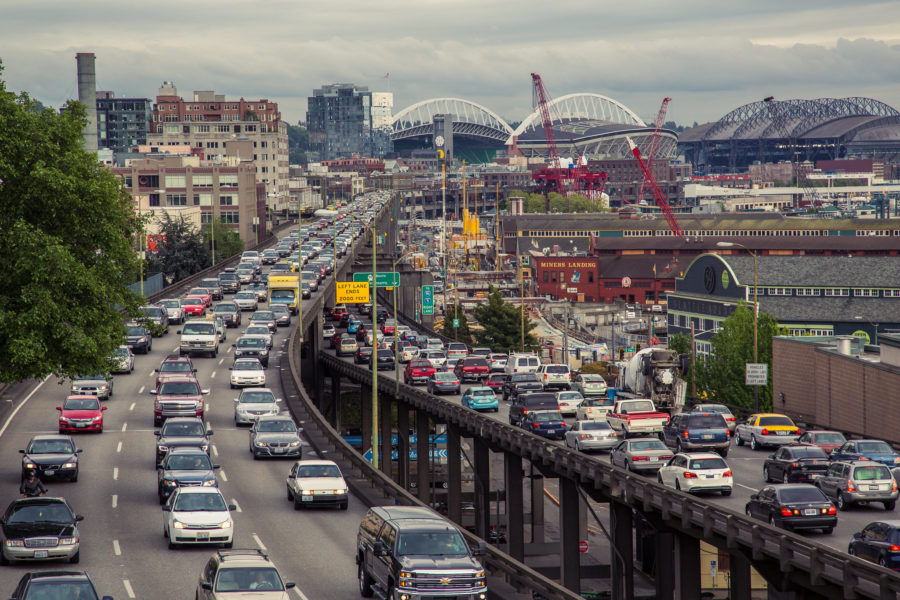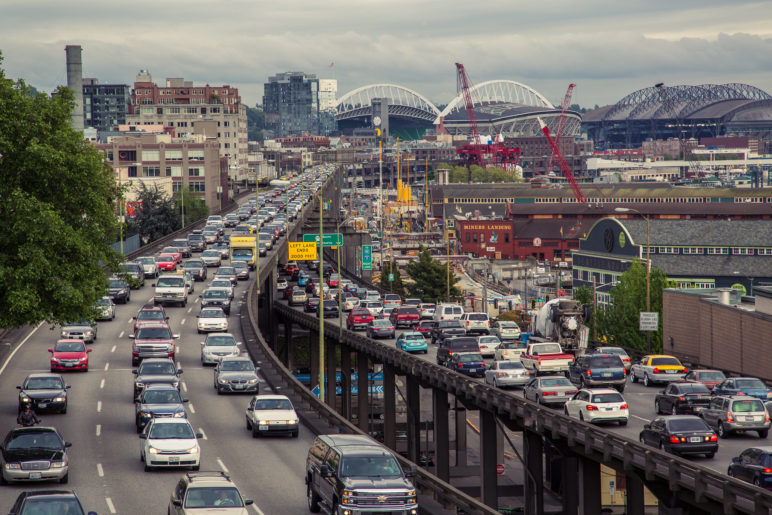Trafficopalypse. The Big Clog. Carmageddon. And now Viadoom.
It seems like the same story every time. Transportation planners announce the impending closure of urban highway lanes. Pundits and tongue-waggers confidently predict a terrifying hell-scape of congestion. But as soon as the lanes actually close, travelers quickly adjust, and the anticipated gridlock never materializes.
It happened in Seattle just over a decade ago, when WSDOT closed two lanes of Interstate 5 just south of downtown Seattle. Front page headlines in both daily papers (yes, the city had two papers back then) predicted that traffic would seize up throughout the metro area, with backups stretching from Seattle all the way to Tacoma. But travelers had plenty of time and warning to adjust their plans. Commuters changed the timing of their morning and afternoon routines. Some took time off or worked from home. Others switched modes, opting for transit or bikes rather than cars. Still others changed their destinations, running errands closer to home to avoid hopping on the highway.
The result was two weeks with the breeziest commutes in years.
Something similar seems to be happening now with “Viadoom.” The Alaskan Way Viaduct, the elevated highway hugging Seattle’s waterfront, was permanently closed to traffic on January 11. And while articles in The Seattle Times forecast “gridlock” and the “worst traffic period ever,” the reality has been far more subdued. Peaceful, even.
During the first Monday morning commute, rush hour started a bit early—but also dissipated about an hour early. Three days into the first workweek without the Viaduct, the Times summed up the new commute as “some delays but no crises.” Five days in, traffic remained “average.” Suburban commuters barely noticed a change—except, perhaps, a slight easing of demand at park-and-rides. Even Seattle school bus drivers found that things went “better than expected.”
Not everything went swimmingly, of course. West Seattle commuters faced an uptick in congestion. Early-morning commuters dealt with longer delays than usual. Accidents on I-5 seemed to have a particularly big impact on traffic flows.
Even so, cars and buses kept moving through the city, even as biking and ridesharing boomed. The doom-filled predictions never materialized. Of course, things could still get worse over the next few weeks. And maybe they’d get much, much worse if “Viadoom” were to last more than a few weeks.
Then again, maybe not.
Readers with long memories may recall that the Viaduct was once something of an obsession of mine. A little over 15 years ago I wrote an article for The Stranger, arguing that Seattle could actually thrive without a waterfront highway, pointing out that other cities that had removed urban highways thrived without descending into gridlock. A few years later I ran numbers on how Seattle’s transportation system could adapt to losing the Viaduct by boosting transit and shifting car trips onto the street grid, even without replacing the highway with a tunnel. Once the tunnel plans started moving forward, I reviewed evidence that the city might actually face more congestion with a tunnel than without it. Heck, we ran a whole blog series on the Viaduct, 56 articles strong.
Now, for these few weeks, we get to see what Seattle’s transportation system might have been like if we’d torn down the Viaduct and replaced it with nothing at all. And maybe, just maybe, that experience will offer at least one piece of evidence that Seattle without a waterfront highway could have been a lot more livable than so many of us thought it would be.










Eldan Goldenberg
The other thing I find interesting about this instance is that Seattle failed to do a number of the mitigation steps that had originally planned (e.g. wasn’t the Center City Connector originally supposed to have opened before the viaduct closed?), and has some other good car traffic reduction work in the pipeline (Link extension, possible congestion charging). I was a bit worried about Viadoom because of what hadn’t been completed yet, but it’s nice to have been wrong about that one. More importantly: the other projects mean that even if traffic were to rebound in the long run we’d have some capacity to deal with that. All of which really does leave me feeling like we don’t need that tunnel after all….
SounderTID
We aren’t seeing double-digit increase in transit boardings. That may be early evidence that we’re looking at overall reduction in activity, e.g. less trade, less tourism and possibly less overall economic activity due to the highway closure.
We’ll find out when there’s data on the impacts on GDP in a few months. January is likely the best time of year for this kind of disruption to happen.
Pike Oliver
It is great to see less traffic doom than anticipated. But it is also important to keep in mind that it is one thing to adjust and/or defer travel over a few weeks and quite another to do that permanently. So I’d be careful about drawing conclusions from this brief three and a half period in between closing the viaduct and opening the tunnel.
Darin Johnson
Expanding on Pike Oliver’s comments above, I’m not sure it’s fair to extrapolate from this relatively brief period without the viaduct to what it would be like without it permanently.
First, as a West Seattleite, I have simply avoided downtown during this time. That’s not really a viable strategy forever. I wonder how you’ve factored that in to your thinking: if traffic is reduced in response to the viaduct being down, that’s a *cost*, not a benefit.
Second, part of the benefit of having multiple routes is flexibility in case something goes wrong. This risk may not show up in a short sample.